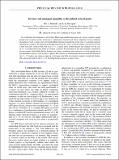Intrinsic and emergent anomalies at deconfined critical points
Author(s)
Thorngren, Ryan; Metlitski, Maxim A.
DownloadPhysRevB.98.085140.pdf (627.8Kb)
PUBLISHER_POLICY
Publisher Policy
Article is made available in accordance with the publisher's policy and may be subject to US copyright law. Please refer to the publisher's site for terms of use.
Terms of use
Metadata
Show full item recordAbstract
It is well known that theorems of Lieb-Schultz-Mattis type prohibit the existence of a trivial symmetric gapped ground state in certain systems possessing a combination of internal and lattice symmetries. In the continuum description of such systems, the Lieb-Schultz-Mattis theorem is manifested in the form of a quantum anomaly afflicting the symmetry. We demonstrate this phenomenon in the context of the deconfined critical point between a Neel state and a valence bond solid in an S=1/2 square lattice antiferromagnet and compare it to the case of S=1/2 honeycomb lattice where no anomaly is present. We also point out that new anomalies, unrelated to the microscopic Lieb-Schultz-Mattis theorem, can emerge, prohibiting the existence of a trivial gapped state in the immediate vicinity of critical points or phases. For instance, no translationally invariant weak perturbation of the S=1/2 gapless spin chain can open up a trivial gap even if the spin-rotation symmetry is explicitly broken. The same result holds for the S=1/2 deconfined critical point on a square lattice.
Date issued
2018-08Department
Massachusetts Institute of Technology. Department of PhysicsJournal
Physical Review B
Publisher
American Physical Society
Citation
Metlitski, Max A., and Ryan Thorngren. “Intrinsic and Emergent Anomalies at Deconfined Critical Points.” Physical Review B, vol. 98, no. 8, Aug. 2018. © 2018 American Physical Society
Version: Final published version
ISSN
2469-9950
2469-9969